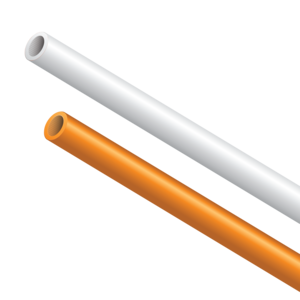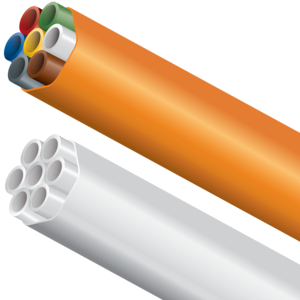In today's interconnected world, sustainability is no longer just a buzzword; it's an essential part of investments across all industries, including fibre networks. As operators in Europe ramp up their efforts to meet ambitious EU net-zero targets, the focus on reducing carbon emissions has never been more critical.
This shift toward sustainability is not just about ticking boxes on environmental, social, and governance (ESG) reports—it's about fundamentally transforming how fibre networks are designed, deployed, and maintained.
Understanding Carbon Emissions in Fibre Networks
Understanding emissions categories and their specific implications for the telecommunications industry can help operators identify the biggest portion of their carbon footprint and where it lies in the value chain. Carbon emissions are generally classified into three categories, or “scopes”:
- Scope 1: These are direct emissions from sources owned or controlled by the company, such as fuel combustion in company vehicles.
- Scope 2: Indirect emissions come from the consumption of purchased electricity, steam, heating, and cooling.
- Scope 3: This category encompasses all other indirect emissions that occur within the value chain, both upstream and downstream, including emissions from the production of goods and services purchased by the company, and those generated by customers using the company's products and services.
For telecom operators, the vast majority of carbon emissions—up to 98% by some estimates—fall under Scope 3. Given that these emissions largely fall outside the direct control of the company, reducing them means all of us in the industry must come together to make positive changes.
A Holistic Approach to Reducing Scope 3 Emissions
As the demand for fibre networks continues to grow, the challenge for the telecommunications industry is to expand connectivity—and, therefore, infrastructure—without increasing our carbon footprint. Sustainability efforts often seem synonymous with compromise, but a holistic approach can help us achieve our goals while minimising impacts on growth. Here are four strategies that can significantly reduce Scope 3 emissions and promote a circular economy within fibre networks.
1. Harness the Power of Advancing Technology
New automated network design platforms Automated network design offers a powerful solution to help us meet sustainability requirements by designing for environmental impact at the very beginning. By utilising advanced algorithms, abundant topographical data, and a greater overall set of inputs, automated design tools can quickly produce highly accurate feasibility analyses, deployment plans, and bills of materials.
These tools ensure that the design adheres to architectural rules and compliance requirements, reducing the likelihood of errors that could lead to increased emissions and waste. Some of the many benefits include:
- Increased Accuracy: Automated tools minimise human errors, which means more precise construction plans and fewer adjustments during the deployment phase.
- Reduced Waste: By generating accurate bills of materials, you can avoid overbuying materials, and thereby avoid sending more product to landfills.
- Fewer Truck Rolls; Less Direct Emissions: The increased precision of automated plans can help you reduce construction errors and the need for site visits for feasibility studies and maintenance – fewer trips to the site means lower direct emissions.
By embracing automated network design, operators can not only enhance the efficiency of their operations but also make significant strides toward reducing their environmental impact. You can learn more about these cutting-edge design capabilities from our sister company, Biarri Networks.
2. Elevate Standards in Industry Training
The skills and training gap is familiar to most of us by now – our existing challenges are compounded by a shortage of skilled workers, difficulties in retaining talent, an aging workforce, and evolving learning preferences. But by adapting our approach to education, we can address the skills gap and promote knowledge and best practices that will increase sustainability across the board – here are some of the ways we can accomplish this:
- Online Training: Moving training programs online makes learning more accessible and interactive, and most important, more engaging.
- Just-in-Time Learning: Shorter, more digestible, and more agile training modules reduce wasted time and allow learners to train on the go, getting them out in the field sooner for vital hands-on, on-the-job learning.
- Collaborative Training: Industry-wide partnerships can pool resources and expertise, providing comprehensive training that covers all aspects of network deployment.
It’s a win-win—improving industry training standards not only enhances the quality of network installations but also reduces errors and the need for corrective maintenance, further minimising waste and lowering emissions. If you’re ready to upskill your workforce with modern, accessible, and engaging content, check out Dura-Line Academy, our industry-leading online training platform.
3. Collaborate to Enable Circularity in the Supply Chain
Because such a significant portion of a telecommunications company's total carbon emissions, falls under Scope 3, circularity in the supply chain is critical for managing these emissions effectively. But any one organisation can’t accomplish this alone – to achieve circularity, collaboration across the industry is essential.
Let’s look at two of the key pillars of a circularity:
- Reusing and Recycling: Implementing circular economy practices, such as sharing, leasing, reusing, repairing, refurbishing, and recycling materials, can extend product life cycles and reduce waste. This approach not only conserves resources but also lowers the overall environmental impact.
- Design for Longevity: A shocking 80% of lifetime emissions are determined in the product design phase. But by creating products that last longer and can be easily recycled, companies can reduce the frequency of replacements and the associated emissions.
4. Adopt a Common Sustainability Language
One of the challenges in advancing sustainability within the telecommunications industry is the lack of a unified framework for measuring and reporting sustainability efforts. If each company’s sustainability reporting is unique, it will make comparing progress across the industry even more difficult.
To help move the industry toward this, we’ve worked with industry peers via platforms like the FTTH Council and NLConnect to promote a standardised approach to sustainability in the region. We contributed to new Product Category Rules (PCRs), recently published by NLConnect, which help end users make accurate comparisons between solutions and ultimately aid customer adoption.
Adopting a common sustainability language and aligning with these regulatory frameworks will enable telecommunications companies to benchmark their efforts, improve transparency and accountability, and drive industry-wide progress toward sustainability goals.
What does circularity look like in practice?
For Dura-Line, it means reworking routine fallout from the conduit extrusion process back into HDPE pellets that can be extruded into installable products for customers—like our life cycle assessment-backed MicroDucts and FuturePath ECO™— in support of their own sustainability and net-zero ambitions. And because we select only the highest-quality resins from the best external sources, we know these products will meet the same stringent industry performance parameters as standard MicroDuct products, with 40% lower carbon emissions.
By collaborating with suppliers and other stakeholders to implement circular economy principles, telecommunications companies can make significant progress in reducing their Scope 3 emissions and promoting sustainability across the value chain. This was seen recently in The Netherlands, where KPN deployed MicroDucts and FuturePath ECO™ in their networks.

What We’re Doing to Create Sustainable Connectivity
At Dura-Line, we’re taking action to achieve our sustainability goals and supporting others as they work toward theirs. You can learn more about our sustainability goals and how we’re reaching them here.




